26 Aug Love Wins: Remembering David Baker
The Folk School community lost...

The Folk School community lost...
 Marbles created by students in Carla's Flameworking 101 class.[/caption]
Have you ever wanted to experience the magic of moving molten glass? Flameworking 101 might be the craft for you! We are lucky to have Carla Camasso teach the art of flamework, also known as lampwork. Carla is a glass artist currently living in Asheville, North Carolina. Using a torch to melt and manipulate borosilicate glass, her work is greatly inspired by the beauty of nature. Learn more about Carla in this sweet interview I did with her in the Folk School Dining Hall during the week of her last class with us.
[caption id="attachment_17899" align="alignright" width="246"]
Marbles created by students in Carla's Flameworking 101 class.[/caption]
Have you ever wanted to experience the magic of moving molten glass? Flameworking 101 might be the craft for you! We are lucky to have Carla Camasso teach the art of flamework, also known as lampwork. Carla is a glass artist currently living in Asheville, North Carolina. Using a torch to melt and manipulate borosilicate glass, her work is greatly inspired by the beauty of nature. Learn more about Carla in this sweet interview I did with her in the Folk School Dining Hall during the week of her last class with us.
[caption id="attachment_17899" align="alignright" width="246"]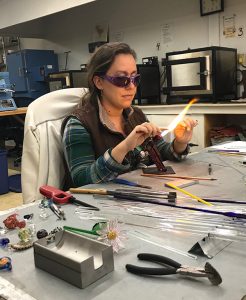 Carla working on the torch in the Folk School studio[/caption]
CP: What is flamework?
CC: Flamework is a form of glass work. You use a table top torch to sculpt and melt rods of glass and glass color into many different shapes and forms. This week we are making marbles, pendants, ornaments, and small sculptures.
CP: How is flamework different from bead making?
CC: Bead making in done with soft glass. My class is focusing on borosilicate glass, which is a harder glass. It’s more user friendly, so it's great for those just starting in glass.
Carla working on the torch in the Folk School studio[/caption]
CP: What is flamework?
CC: Flamework is a form of glass work. You use a table top torch to sculpt and melt rods of glass and glass color into many different shapes and forms. This week we are making marbles, pendants, ornaments, and small sculptures.
CP: How is flamework different from bead making?
CC: Bead making in done with soft glass. My class is focusing on borosilicate glass, which is a harder glass. It’s more user friendly, so it's great for those just starting in glass.
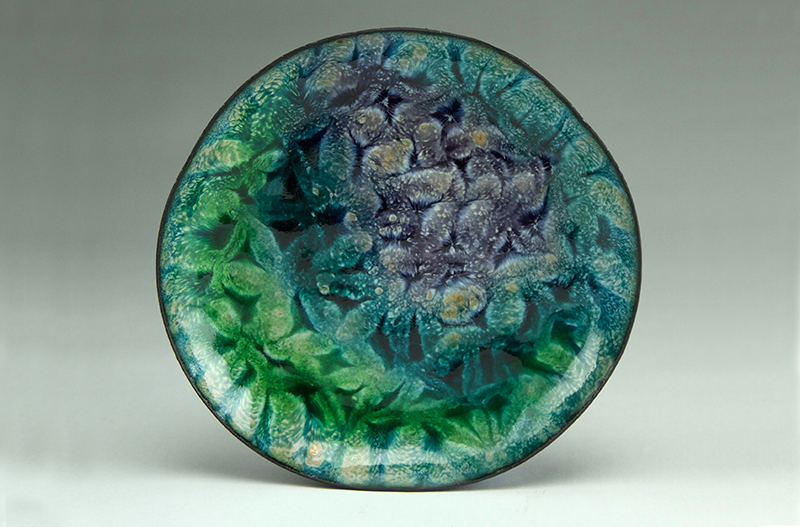 Enameled Bowl by Sienna[/caption]
The summertime at the Folk School offers two opportunities for people under the age of 18 to take classes at the Folk School: Little/Middle Folk School and Intergenerational Week. For many young people, this is an ongoing tradition, so what happens when you turn 18 and age out of these programs? Do not fret, you are not banished from the Folk School! On the contrary, now you can take ANY class all year long.
I recently met Sienna Bosch, an 18-year-old recent high school graduate from Fort Collins, CO who was taking "Beginning Techniques in Enamel" with Christie Schuster. She was here with her mom, who was in printmaking class, and her dad, who taught woodturning. I sat down with her and talked about her experience. Enjoy our interview!
[caption id="attachment_17139" align="alignright" width="278"]
Enameled Bowl by Sienna[/caption]
The summertime at the Folk School offers two opportunities for people under the age of 18 to take classes at the Folk School: Little/Middle Folk School and Intergenerational Week. For many young people, this is an ongoing tradition, so what happens when you turn 18 and age out of these programs? Do not fret, you are not banished from the Folk School! On the contrary, now you can take ANY class all year long.
I recently met Sienna Bosch, an 18-year-old recent high school graduate from Fort Collins, CO who was taking "Beginning Techniques in Enamel" with Christie Schuster. She was here with her mom, who was in printmaking class, and her dad, who taught woodturning. I sat down with her and talked about her experience. Enjoy our interview!
[caption id="attachment_17139" align="alignright" width="278"]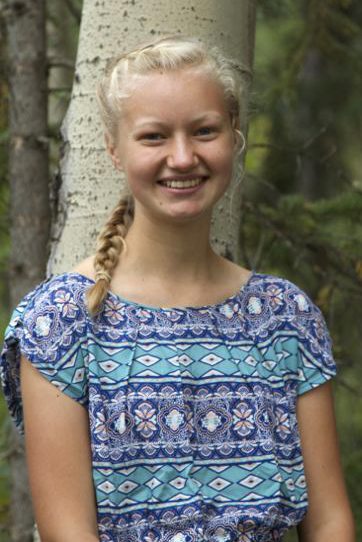 Sienna Bosch[/caption]
Sienna Bosch[/caption]
CP: Had you been to the Folk School before this trip?
SB: I had never been to the Folk School before this trip. I had heard a lot about it from my sister and parents, but this was my first time at the Folk School. CP: Do you have a favorite craft? SB: I don't necessarily have a favorite, I work mostly in wood, metal, and wire, but I really enjoy trying new things and experimenting with a variety of crafts. [caption id="attachment_17137" align="alignleft" width="300"]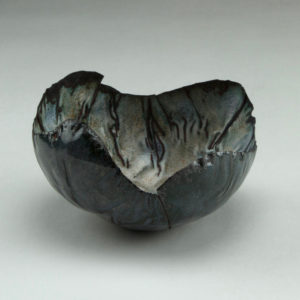 Enameled Bowl by Sienna[/caption]
CP: Why did you decide to take Enameling?
SB: I decided to take enameling because it was something that I had never tried before, but was interested in. I had seen pictures of enameled copper and was curious what the process was like. There were many classes that sounded interesting to me, but enameling really sparked my interest.
Enameled Bowl by Sienna[/caption]
CP: Why did you decide to take Enameling?
SB: I decided to take enameling because it was something that I had never tried before, but was interested in. I had seen pictures of enameled copper and was curious what the process was like. There were many classes that sounded interesting to me, but enameling really sparked my interest.
Kay Patterson teaches many times...
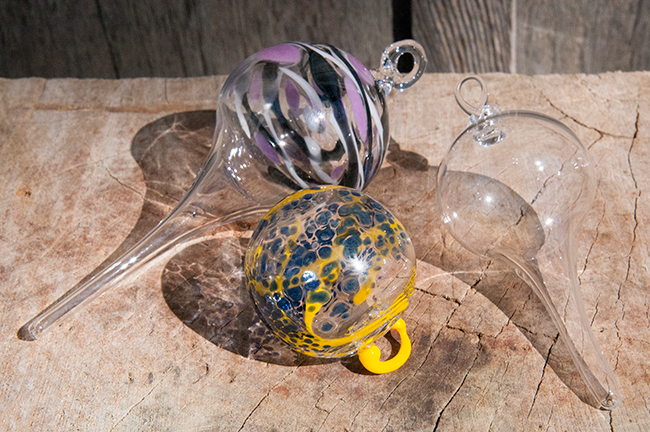 Blown glass ornaments by student Dylan Goodson[/caption]
[caption id="attachment_14403" align="alignright" width="328"]
Blown glass ornaments by student Dylan Goodson[/caption]
[caption id="attachment_14403" align="alignright" width="328"]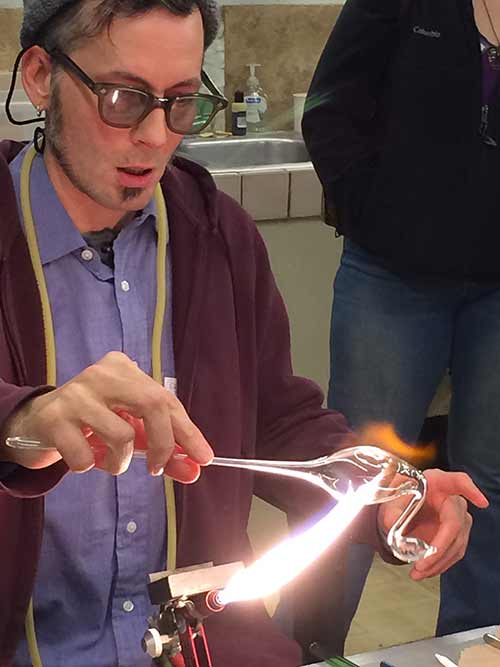 Tony Prince shapes a glass blown swan with the heat of the torch.[/caption]
What do swans, jellyfish, marbles, icicles, and ornaments have in common? These design shapes are just a few of the incredible student projects you could see this week in "Intro to Glass Blowing," co-taught by Alex Greenwood and Tony Prince. Using tabletop torches, students are learning the craft of manipulating tubes and rods of borosilicate glass into unique glassblown ornaments and small vessels.
Last night, I attended Tony's demonstration in the studio. Many Folk School folks packed the room, eager to see the torch in action and the experience the excitement of moving glass. Tony explained that glass material comes in many forms: a solid rod, a hollow tubing, and thinner colored rods and that there are many ways to use and connect the different types of glass.
Everyone looked on while Tony lit the torch and prepared the tube to make a hollow swan. When the glass tube was hot enough, Tony blew into the tube and the body of the swan rounded out like magic! He made it look so easy. Tony described it like blowing bubble gum or blowing up a balloon.
Tony Prince shapes a glass blown swan with the heat of the torch.[/caption]
What do swans, jellyfish, marbles, icicles, and ornaments have in common? These design shapes are just a few of the incredible student projects you could see this week in "Intro to Glass Blowing," co-taught by Alex Greenwood and Tony Prince. Using tabletop torches, students are learning the craft of manipulating tubes and rods of borosilicate glass into unique glassblown ornaments and small vessels.
Last night, I attended Tony's demonstration in the studio. Many Folk School folks packed the room, eager to see the torch in action and the experience the excitement of moving glass. Tony explained that glass material comes in many forms: a solid rod, a hollow tubing, and thinner colored rods and that there are many ways to use and connect the different types of glass.
Everyone looked on while Tony lit the torch and prepared the tube to make a hollow swan. When the glass tube was hot enough, Tony blew into the tube and the body of the swan rounded out like magic! He made it look so easy. Tony described it like blowing bubble gum or blowing up a balloon.
David Baker lights up any...
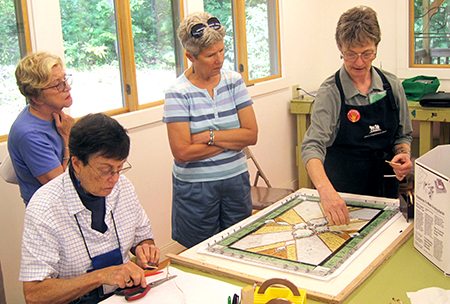 Karen teaches "Classical Stained Glass Panels" in the Jewelry Studio at the Folk School.[/caption]
Karen teaches "Classical Stained Glass Panels" in the Jewelry Studio at the Folk School.[/caption]
CP: Why do you like glass?
KR: Glass is a magical, magical, magical medium. Never a liquid or a solid, glass is always in between those two states of matter. Through heat, you can control its characteristics. I believe that there are endless possibilities in glass as a creative medium. It is a wonderful combination of "science meets art." The way you see glass is all about the light.
CP: What made made you want to be a glass artist?
[caption id="attachment_8864" align="alignleft" width="184"]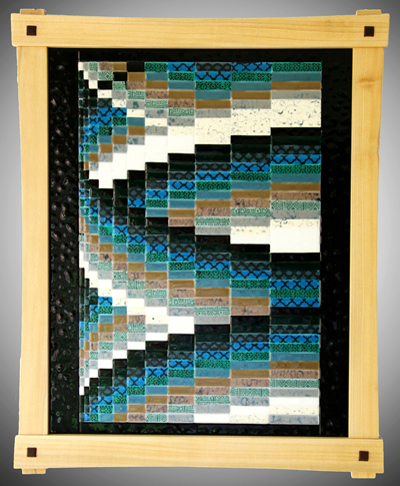 Bargello-inspired piece[/caption]
Bargello-inspired piece[/caption]
KR: I was into many crafts and I especially loved quilting - piecing things together. For Valentine's Day in 1981, my husband gave me a pair of grozing pliers and a glass cutter and encouraged me to try glass. Working with glass filled my soul, so I started my love affair with cold glass techniques (like stained glass) etched under 1000 degrees.
From there I wanted to try it all, so I learned warm glass techniques (like fusing, fritting, and ground glass) and plastic glass which is glass at a temperature above 1650 degrees (like beading). Now I have been working and teaching glass for over 30 years. My studio out of Huntsville, AL is Earthstar Glass.
CP: What inspires you?
[caption id="attachment_8866" align="alignright" width="192"]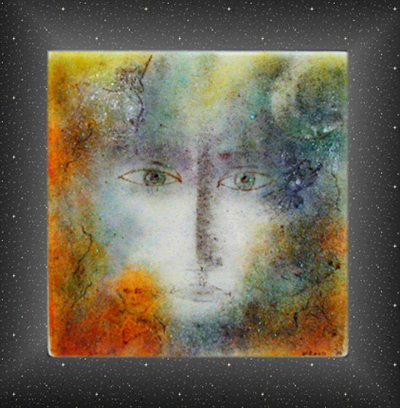 An example of Powder Painting achieving a watercolor look by Karen Reed.[/caption]
An example of Powder Painting achieving a watercolor look by Karen Reed.[/caption]
KR: Creative challenges. I take inspiration from other media, like oil painting, watercolor, pastels, quilting, and think: "I would like to figure that out in glass."
I also take technique driven inspiration from different cultures around the world, I get lost in a subject. For example, I look at Balinese Folk Art and wonder "how can I make that in glass?"
CP: Functional or Decorative?
KR: It's a balance. As an independent studio we need to do functional work and custom pieces to fund our other more conceptual and creative pieces. My creative work is what goes in the galleries, the functional and smaller-sized work pays the bills. Small will sell better, but I love doing the big pieces.
CP: Who is your favorite glass artist?
KR: Harry Clarke (1889 -1931) a master of stained glass from Ireland.
CP: What’s the most meaningful piece you’ve ever made?
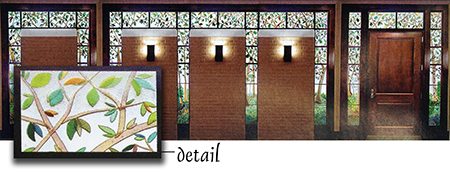
KR: The 57 fused glass panels for the chapel in Madison, AL. In 2012, I was commissioned by three siblings to create an installation piece in a hospital chapel to commemorate their parents. Because of a lead ban, you cannot put lead in a hospital, so the siblings had a hard time finding an artist to hire. I have been fusing glass over 25 years and was honored and delighted to be able to work on such a commission. I loved every second of it! They wanted something soothing, non-denominational and artistic with nature as a theme - a place of retreat for everyone to enjoy.


